Estimation of Biomass Burning Emissions in South and Southeast Asia Based on FY-4A Satellite Observations
Abstract
1. Introduction
2. Materials and Methods
2.1. Study Area
2.2. Data
2.3. Methods
3. Results
3.1. Spatial Patterns of OBB Emissions
3.2. Temporal Patterns of OBB Emissions
4. Discussion
4.1. Effect of Fire Intensity on Emissions
4.2. Relationship Between Interannual Variation of OBB Emissions and Landcover
4.3. Comparison with Other Research Results
5. Conclusions
Author Contributions
Funding
Institutional Review Board Statement
Informed Consent Statement
Data Availability Statement
Conflicts of Interest
Abbreviations
| FY-4A | Feng Yun-4A |
| OBB | Open Biomass Burning |
| FEER | Fire Emissions and Energy Research |
| AGRI | Advanced Geostationary Radiation Imager |
| MODIS | Moderate Resolution Imaging Spectroradiometer |
| GFED | Global Fire Emissions Database |
| GFAS | Global Fire Assimilation System |
| SSEA | South and Southeast Asia |
| EQAS | Equatorial Asia |
| SEAS | South Asia |
| FRE | Fire Radiative Energy |
| FRP | Fire Radiative Power |
| IGBP | International Geosphere—Biosphere Programme |
| C | Carbon |
| FY-3D | Feng Yun-3D |
| CO2 | Carbon Dioxide |
| CO | Carbon Monoxide |
| CH4 | Methane |
| H2 | Hydrogen |
| NOX | Nitrogen Oxide |
| SO2 | Sulfur Dioxide |
| PM2.5 | Particulate Matter ≤ 2.5 μm |
| TPM | Total Particulate Matter |
| TPC | Total Particulate Carbon |
| OC | Organic Carbon |
| BC | Black Carbon |
| NH3 | Ammonia |
| NO | Nitric Oxide |
| NO2 | Nitrogen Dioxide |
| NMHC | Non-Methane Hydrocarbon |
| PM10 | Particulate Matter ≤ 10 μm |
References
- Connolly, R.; Marlier, M.E.; Garcia-Gonzales, D.A.; Wilkins, J.; Su, J.; Bekker, C.; Jung, J.; Bonilla, E.; Burnett, R.T.; Zhu, Y.; et al. Mortality Attributable to PM2.5 from Wildland Fires in California from 2008 to 2018. Sci. Adv. 2024, 10, eadl1252. [Google Scholar] [CrossRef]
- Chang, D.Y.; Jeong, S.; Park, C.-E.; Park, H.; Shin, J.; Bae, Y.; Park, H.; Park, C.R. Unprecedented Wildfires in Korea: Historical Evidence of Increasing Wildfire Activity Due to Climate Change. Agric. For. Meteorol. 2024, 348, 109920. [Google Scholar] [CrossRef]
- Chen, Y.; Hall, J.; van Wees, D.; Andela, N.; Hantson, S.; Giglio, L.; van der Werf, G.R.; Morton, D.C.; Randerson, J.T. Multi-Decadal Trends and Variability in Burned Area from the Fifth Version of the Global Fire Emissions Database (GFED5). Earth Syst. Sci. Data 2023, 15, 5227–5259. [Google Scholar] [CrossRef]
- Reddington, C.L.; Conibear, L.; Robinson, S.; Knote, C.; Arnold, S.R.; Spracklen, D.V. Air Pollution from Forest and Vegetation Fires in Southeast Asia Disproportionately Impacts the Poor. Geohealth 2021, 5, e2021GH000418. [Google Scholar] [CrossRef]
- Singh, P.; Roy, A.; Bhasin, D.; Kapoor, M.; Ravi, S.; Dey, S. Crop Fires and Cardiovascular Health—A Study from North India. SSM Popul. Health 2021, 14, 100757. [Google Scholar] [CrossRef]
- Irfan, H. Air Pollution and Cardiovascular Health in South Asia: A Comprehensive Review. Curr. Probl. Cardiol. 2024, 49, 102199. [Google Scholar] [CrossRef]
- Thao, N.N.L.; Pimonsree, S.; Prueksakorn, K.; Thao, P.T.B.; Vongruang, P. Public Health and Economic Impact Assessment of PM2.5 from Open Biomass Burning over Countries in Mainland Southeast Asia during the Smog Episode. Atmos. Pollut. Res. 2022, 13, 101418. [Google Scholar] [CrossRef]
- Xu, Y.; Huang, Z.; Ou, J.; Jia, G.; Wu, L.; Liu, H.; Lu, M.; Fan, M.; Wei, J.; Chen, L.; et al. Near-Real-Time Estimation of Hourly Open Biomass Burning Emissions in China Using Multiple Satellite Retrievals. Sci. Total Environ. 2022, 817, 152777. [Google Scholar] [CrossRef]
- Shi, Y.; Gong, S.; Zang, S.; Zhao, Y.; Wang, W.; Lv, Z.; Matsunaga, T.; Yamaguchi, Y.; Bai, Y. High-Resolution and Multi-Year Estimation of Emissions from Open Biomass Burning in Northeast China during 2001–2017. J. Clean. Prod. 2021, 310, 127496. [Google Scholar] [CrossRef]
- Liu, M.; Popescu, S. Estimation of Biomass Burning Emissions by Integrating ICESat-2, Landsat 8, and Sentinel-1 Data. Remote Sens. Environ. 2022, 280, 113172. [Google Scholar] [CrossRef]
- Pereira, G.; Longo, K.M.; Freitas, S.R.; Mataveli, G.; Oliveira, V.J.; Santos, P.R.; Rodrigues, L.F.; Cardozo, F.S. Improving the South America Wildfires Smoke Estimates: Integration of Polar-Orbiting and Geostationary Satellite Fire Products in the Brazilian Biomass Burning Emission Model (3BEM). Atmos. Environ. 2022, 273, 118954. [Google Scholar] [CrossRef]
- van der Werf, G.R.; Randerson, J.T.; Giglio, L.; van Leeuwen, T.T.; Chen, Y.; Rogers, B.M.; Mu, M.; van Marle, M.J.E.; Morton, D.C.; Collatz, G.J.; et al. Global Fire Emissions Estimates during 1997–2016. Earth Syst. Sci. Data 2017, 9, 697–720. [Google Scholar] [CrossRef]
- Shi, Y.; Zhao, A.; Matsunaga, T.; Yamaguchi, Y.; Zang, S.; Li, Z.; Yu, T.; Gu, X. High-Resolution Inventory of Mercury Emissions from Biomass Burning in Tropical Continents during 2001–2017. Sci. Total Environ. 2019, 653, 638–648. [Google Scholar] [CrossRef]
- Shi, Y.; Zang, S.; Matsunaga, T.; Yamaguchi, Y. A Multi-Year and High-Resolution Inventory of Biomass Burning Emissions in Tropical Continents from 2001–2017 Based on Satellite Observations. J. Clean. Prod. 2020, 270, 122511. [Google Scholar] [CrossRef]
- Wiedinmyer, C.; Kimura, Y.; McDonald-Buller, E.C.; Emmons, L.K.; Buchholz, R.R.; Tang, W.; Seto, K.; Joseph, M.B.; Barsanti, K.C.; Carlton, A.G.; et al. The Fire Inventory from NCAR Version 2.5: An Updated Global Fire Emissions Model for Climate and Chemistry Applications. Geosci. Model Dev. 2023, 16, 3873–3891. [Google Scholar] [CrossRef]
- Scarpa, C.; Bacciu, V.; Ascoli, D.; Costa-Saura, J.M.; Salis, M.; Sirca, C.; Marchetti, M.; Spano, D. Estimating Annual GHG and Particulate Matter Emissions from Rural and Forest Fires Based on an Integrated Modelling Approach. Sci. Total Environ. 2024, 907, 167960. [Google Scholar] [CrossRef]
- Johnston, J.M.; Wooster, M.J.; Paugam, R.; Wang, X.; Lynham, T.J.; Johnston, L.M. Direct Estimation of Byram’s Fire Intensity from Infrared Remote Sensing Imagery. Int. J. Wildland Fire 2017, 26, 668–684. [Google Scholar] [CrossRef]
- Zhou, Y.; Xia, X.; Lang, J.; Zhao, B.; Chen, D.; Mao, S.; Zhang, Y.; Liu, J.; Li, J. A Coupled Framework for Estimating Pollutant Emissions from Open Burning of Specific Crop Residue: A Case Study for Wheat. Sci. Total Environ. 2022, 844, 156731. [Google Scholar] [CrossRef]
- Wan, N.; Xiong, X.; Kluitenberg, G.J.; Hutchinson, J.M.S.; Aiken, R.; Zhao, H.; Lin, X. Estimation of Biomass Burning Emission of NO2 and CO from 2019–2020 Australia Fires Based on Satellite Observations. Atmos. Chem. Phys. 2023, 23, 711–724. [Google Scholar] [CrossRef]
- Freeborn, P.H.; Wooster, M.J.; Hao, W.M.; Ryan, C.A.; Nordgren, B.L.; Baker, S.P.; Ichoku, C. Relationships between Energy Release, Fuel Mass Loss, and Trace Gas and Aerosol Emissions during Laboratory Biomass Fires. J. Geophys. Res. Atmos. 2008, 113. [Google Scholar] [CrossRef]
- de Moura, F.R.; Machado, P.D.W.; Ramires, P.F.; Tavella, R.A.; Carvalho, H.; da Silva Júnior, F.M.R. In the Line of Fire: Analyzing Burning Impacts on Air Pollution and Air Quality in an Amazonian City, Brazil. Atmos. Pollut. Res. 2024, 15, 102033. [Google Scholar] [CrossRef]
- Kaiser, J.; Huijnen, V.; Remy, S.; Ytre-Eide, M.A.; De Jong, M.C.; Zheng, B.; Wiedinmyer, C. Evaluation of Fire Emissions for HTAP3 with CAMS GFAS and IFS-COMPO. In Proceedings of the EGU General Assembly 2025, Vienna, Austria, 27 April–2 May 2025. [Google Scholar]
- Atalay, H.; Sunar, A.F.; Dervisoglu, A. Spatial Autocorrelation Analysis of CO and NO2 Related to Forest Fire Dynamics. ISPRS Int. J. Geoinf. 2025, 14, 65. [Google Scholar] [CrossRef]
- van Wees, D.; van der Werf, G.R.; Randerson, J.T.; Rogers, B.M.; Chen, Y.; Veraverbeke, S.; Giglio, L.; Morton, D.C. Global Biomass Burning Fuel Consumption and Emissions at 500 m Spatial Resolution Based on the Global Fire Emissions Database (GFED). Geosci. Model Dev. 2022, 15, 8411–8437. [Google Scholar]
- Li, F.; Zhang, X.; Roy, D.P.; Kondragunta, S. Estimation of Biomass-Burning Emissions by Fusing the Fire Radiative Power Retrievals from Polar-Orbiting and Geostationary Satellites across the Conterminous United States. Atmos. Environ. 2019, 211, 274–287. [Google Scholar] [CrossRef]
- Yang, J.; Zhang, Z.; Wei, C.; Lu, F.; Guo, Q. Introducing the New Generation of Chinese Geostationary Weather Satellites, Fengyun-4. Bull. Am. Meteorol. Soc. 2017, 98, 1637–1658. [Google Scholar] [CrossRef]
- Fu, D.; Shi, H.; Gueymard, C.A.; Yang, D.; Zheng, Y.; Che, H.; Fan, X.; Han, X.; Gao, L.; Bian, J.; et al. A Deep-Learning and Transfer-Learning Hybrid Aerosol Retrieval Algorithm for FY4-AGRI: Development and Verification over Asia. Engineering 2024, 38, 164–174. [Google Scholar] [CrossRef]
- Schroeder, W.; Oliva, P.; Giglio, L.; Csiszar, I.A. The New VIIRS 375 m Active Fire Detection Data Product: Algorithm Description and Initial Assessment. Remote Sens. Environ. 2014, 143, 85–96. [Google Scholar] [CrossRef]
- Lasslop, G.; Hantson, S.; Harrison, S.P.; Bachelet, D.; Burton, C.; Forkel, M.; Forrest, M.; Li, F.; Melton, J.R.; Yue, C.; et al. Global Ecosystems and Fire: Multi-model Assessment of Fire-induced Tree-cover and Carbon Storage Reduction. Glob. Chang. Biol. 2020, 26, 5027–5041. [Google Scholar] [CrossRef]
- Vadrevu, K.; Ohara, T.; Justice, C. Land Cover, Land Use Changes and Air Pollution in Asia: A Synthesis. Environ. Res. Lett. 2017, 12, 120201. [Google Scholar] [CrossRef]
- Dadap, N.C.; Cobb, A.R.; Hoyt, A.M.; Harvey, C.F.; Feldman, A.F.; Im, E.-S.; Konings, A.G. Climate Change-Induced Peatland Drying in Southeast Asia. Environ. Res. Lett. 2022, 17, 074026. [Google Scholar] [CrossRef]
- Kuwata, M. Atmospheric Emissions, Processes, and Impacts of Tropical Peatland Fire Haze in Equatorial Asia: A Review. Atmos. Environ. 2024, 331, 120575. [Google Scholar] [CrossRef]
- Fang, T.; Gu, Y.; Yim, S.H.L. Assessing Local and Transboundary Fine Particulate Matter Pollution and Sectoral Contributions in Southeast Asia during Haze Months of 2015–2019. Sci. Total Environ. 2024, 912, 169051. [Google Scholar] [CrossRef]
- Shi, Y.; Matsunaga, T.; Yamaguchi, Y.; Li, Z.; Gu, X.; Chen, X. Long-Term Trends and Spatial Patterns of Satellite-Retrieved PM2.5 Concentrations in South and Southeast Asia from 1999 to 2014. Sci. Total Environ. 2018, 615, 177–186. [Google Scholar] [CrossRef]
- Liu, S.; Xing, J.; Wang, S.; Ding, D.; Chen, L.; Hao, J. Revealing the Impacts of Transboundary Pollution on PM2.5-Related Deaths in China. Environ. Int. 2020, 134, 105323. [Google Scholar] [CrossRef]
- Yin, S.; Wang, X.; Zhang, X.; Guo, M.; Miura, M.; Xiao, Y. Influence of Biomass Burning on Local Air Pollution in Mainland Southeast Asia from 2001 to 2016. Environ. Pollut. 2019, 254, 112949. [Google Scholar] [CrossRef]
- van der Werf, G.R.; Randerson, J.T.; Giglio, L.; Collatz, G.J.; Kasibhatla, P.S.; Arellano Jr, A.F. Interannual Variability in Global Biomass Burning Emissions from 1997 to 2004. Atmos. Chem. Phys. 2006, 6, 3423–3441. [Google Scholar] [CrossRef]
- Giglio, L.; van der Werf, G.R.; Randerson, J.T.; Collatz, G.J.; Kasibhatla, P. Global Estimation of Burned Area Using MODIS Active Fire Observations. Atmos. Chem. Phys. 2006, 6, 957–974. [Google Scholar] [CrossRef]
- Zhao, W.; Zhang, Y.; Shi, Y.; Zeng, Q.; Liang, X.; Zhang, Z. Discussion on Near Real-Time Tracking of Forest Fire Spread Based on Himawari and FY4 Geostationary Satellite Observation. J. Wildl Fire Sci. 2024, 42, 1–8. [Google Scholar]
- Chen, X.; Yang, Y.; Du, J. Distribution and Attribution of Earlier Start of the Growing Season over the Northern Hemisphere from 2001–2018. Remote Sens. 2022, 14, 2964. [Google Scholar] [CrossRef]
- van der Werf, G.R.; Randerson, J.T.; Giglio, L.; Collatz, G.J.; Mu, M.; Kasibhatla, P.S.; Morton, D.C.; DeFries, R.S.; Jin, Y.; van Leeuwen, T.T. Global Fire Emissions and the Contribution of Deforestation, Savanna, Forest, Agricultural, and Peat Fires (1997–2009). Atmos. Chem. Phys. 2010, 10, 11707–11735. [Google Scholar] [CrossRef]
- Roberts, G.; Wooster, M.J.; Xu, W.; He, J. Fire Activity and Fuel Consumption Dynamics in Sub-Saharan Africa. Remote Sens. 2018, 10, 1591. [Google Scholar] [CrossRef]
- Mota, B.; Wooster, M.J. A New Top-down Approach for Directly Estimating Biomass Burning Emissions and Fuel Consumption Rates and Totals from Geostationary Satellite Fire Radiative Power (FRP). Remote Sens. Environ. 2018, 206, 45–62. [Google Scholar] [CrossRef]
- Roberts, G.; Wooster, M.J.; Perry, G.L.W.; Drake, N.; Rebelo, L.-M.; Dipotso, F. Retrieval of Biomass Combustion Rates and Totals from Fire Radiative Power Observations: Application to Southern Africa Using Geostationary SEVIRI Imagery. J. Geophys. Res. Atmos. 2005, 110. [Google Scholar] [CrossRef]
- Lv, Z.; Shi, Y.; Guo, D.; Zhu, Y.; Man, H.; Zhang, Y.; Zang, S. High-Resolution Daily Emission Inventory of Biomass Burning in the Amur-Heilong River Basin Based on MODIS Fire Radiative Energy Data. Remote Sens. 2022, 14, 4087. [Google Scholar] [CrossRef]
- Yin, L.; Du, P.; Zhang, M.; Liu, M.; Xu, T.; Song, Y. Estimation of Emissions from Biomass Burning in China (2003–2017) Based on MODIS Fire Radiative Energy Data. Biogeosciences 2019, 16, 1629–1640. [Google Scholar] [CrossRef]
- Akagi, S.K.; Yokelson, R.J.; Wiedinmyer, C.; Alvarado, M.J.; Reid, J.S.; Karl, T.; Crounse, J.D.; Wennberg, P.O. Emission Factors for Open and Domestic Biomass Burning for Use in Atmospheric Models. Atmos. Chem. Phys. 2011, 11, 4039–4072. [Google Scholar] [CrossRef]
- Khan, I.A.; Khan, S.M.; Jahangir, S.; Ali, S.; Tulindinova, G.K. Carbon Storage and Dynamics in Different Agroforestry Systems. In Agroforestry; Wiley: New York, NY, USA, 2024; pp. 345–374. [Google Scholar]
- Tang, S.; Shan, Y.; Yin, S.; Cao, L.; Chen, X.; Xie, W.; Yu, M.; Feng, S. Recent Advancements in the Emission Characteristics of Forest Ground Smoldering Combustion. Forests 2024, 15, 2099. [Google Scholar] [CrossRef]
- Gatkal, N.R.; Nalawade, S.M.; Sahni, R.K.; Walunj, A.A.; Kadam, P.B.; Bhanage, G.B.; Datta, R. Present Trends, Sustainable Strategies and Energy Potentials of Crop Residue Management in India: A Review. Heliyon 2024, 10, e39815. [Google Scholar] [CrossRef]
- Dubey, A.K.; Kant, Y.; Sengupta, N.; Madhusudanacharyulu, A.S.; Mitra, D. Fire Hotspot and Aerosol Climatology Observation over South Asia Using Satellite Data. In Climate Crisis and Sustainable Solutions; Springer Nature: Singapore, 2024; pp. 107–124. [Google Scholar]
- Bar, S.; Acharya, P.; Parida, B.R.; Sannigrahi, S.; Maiti, A.; Barik, G.; Kumar, N. Investigation of Fire Regime Dynamics and Modeling of Burn Area over India for the Twenty-First Century. Environ. Sci. Pollut. Res. 2024, 31, 53839–53855. [Google Scholar] [CrossRef]
- Adhikari, G.P.; Wang, G. Understanding the Driving Mechanism for Heat Waves Variability over South Asia during El Niño and La Niña Events. Atmos. Res. 2025, 321, 108076. [Google Scholar] [CrossRef]
- Barrow, E.J.; Erb, W.M. A Systematic Review of the Impacts of El Niño-Driven Drought, Fire, and Smoke on Non-Human Primates in Southeast Asia. bioRxiv 2024. [Google Scholar] [CrossRef]
- Hirano, T.; Ohkubo, S.; Itoh, M.; Tsuzuki, H.; Sakabe, A.; Takahashi, H.; Kusin, K.; Osaki, M. Large Variation in Carbon Dioxide Emissions from Tropical Peat Swamp Forests Due to Disturbances. Commun. Earth Environ. 2024, 5, 221. [Google Scholar] [CrossRef]
- Liu, Y.; Chen, J.; Shi, Y.; Zheng, W.; Shan, T.; Wang, G. Global Emissions Inventory from Open Biomass Burning (GEIOBB): Utilizing Fengyun-3D Global Fire Spot Monitoring Data. Earth Syst. Sci. Data 2024, 16, 3495–3515. [Google Scholar] [CrossRef]
- Di Giuseppe, F.; Rémy, S.; Pappenberger, F.; Wetterhall, F. Using the Fire Weather Index (FWI) to Improve the Estimation of Fire Emissions from Fire Radiative Power (FRP) Observations. Atmos. Chem. Phys. 2018, 18, 5359–5370. [Google Scholar] [CrossRef]
- Pan, X.; Ichoku, C.; Chin, M.; Bian, H.; Darmenov, A.; Colarco, P.; Ellison, L.; Kucsera, T.; da Silva, A.; Wang, J.; et al. Six Global Biomass Burning Emission Datasets: Intercomparison and Application in One Global Aerosol Model. Atmos. Chem. Phys. 2020, 20, 969–994. [Google Scholar] [CrossRef]

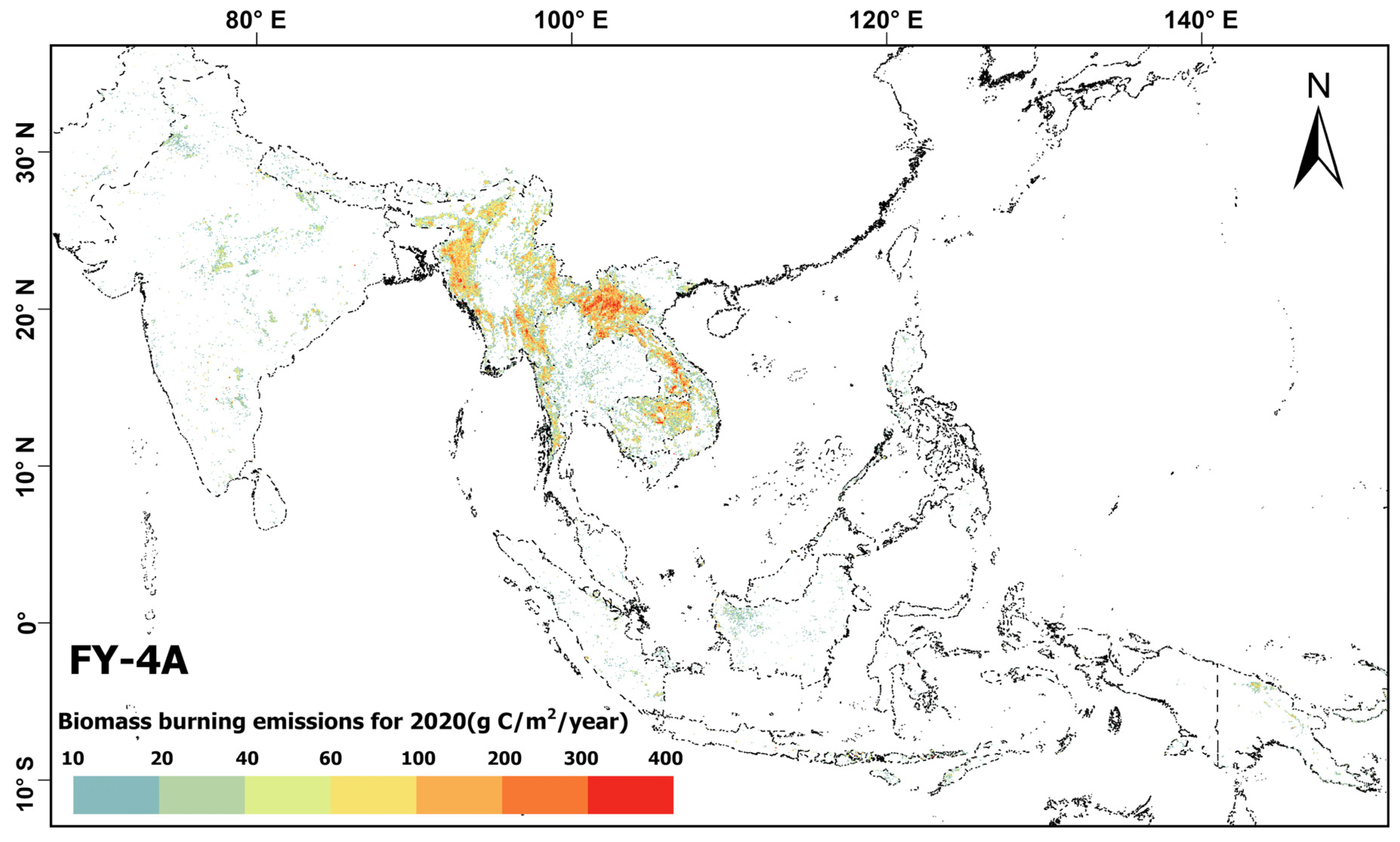
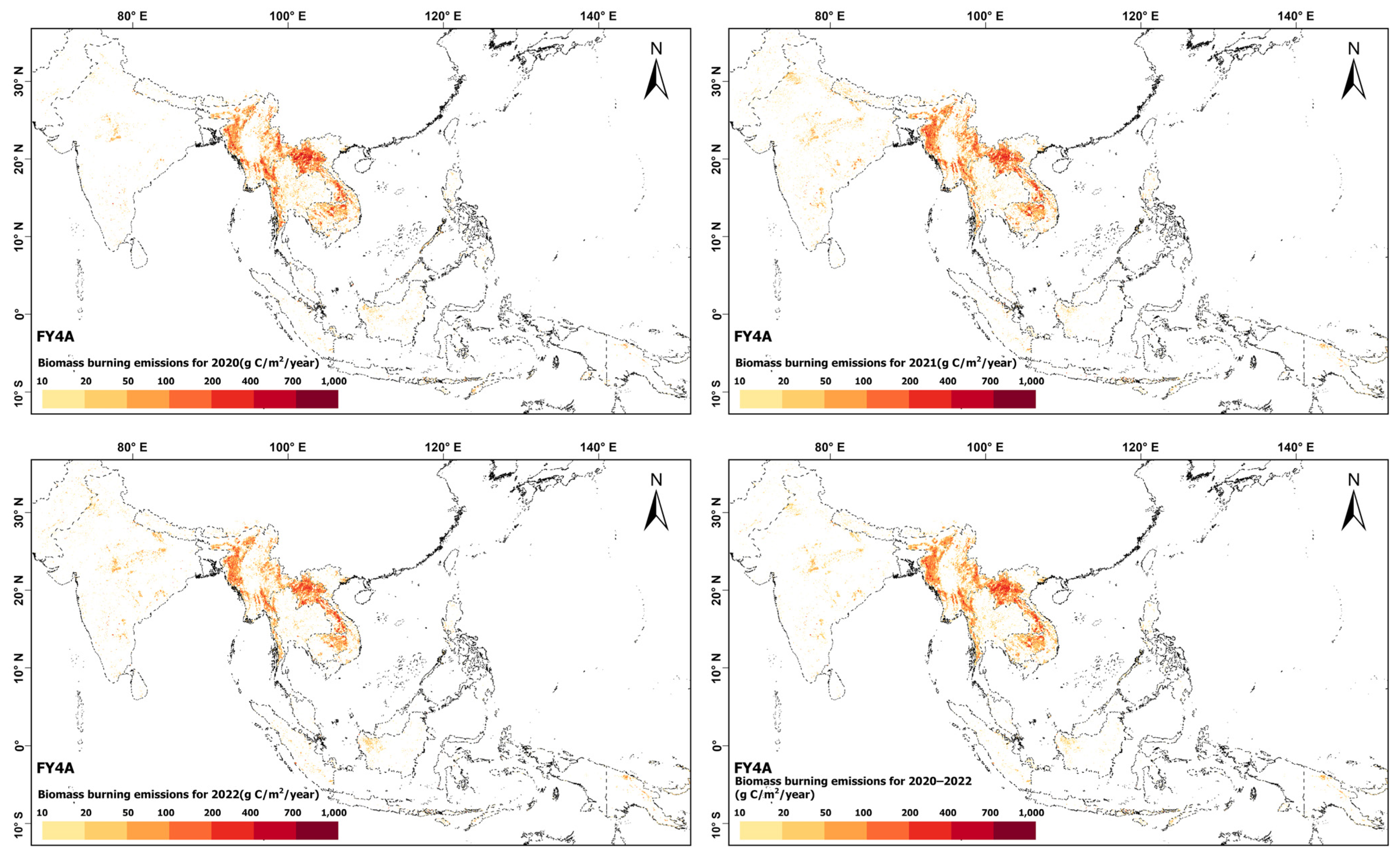
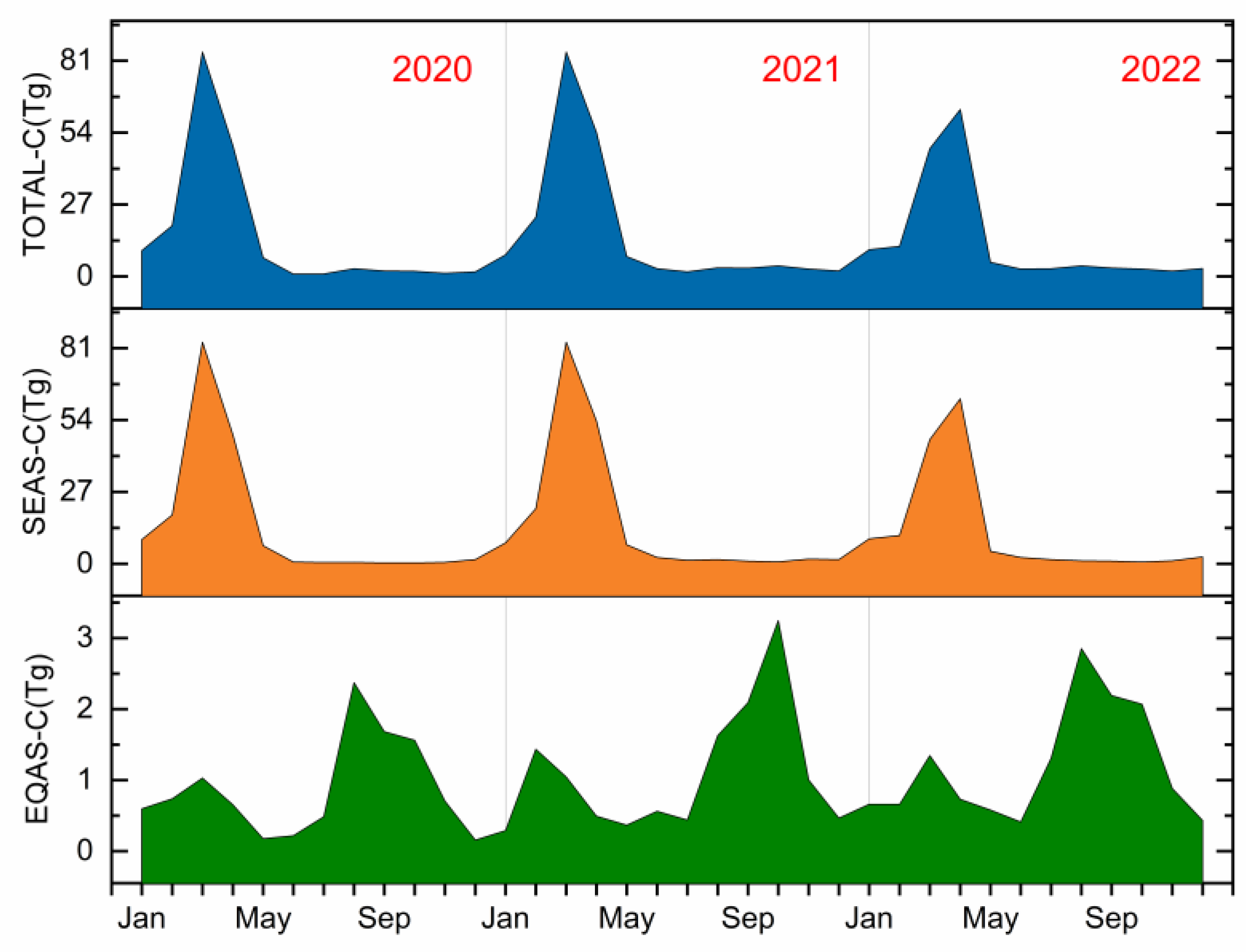
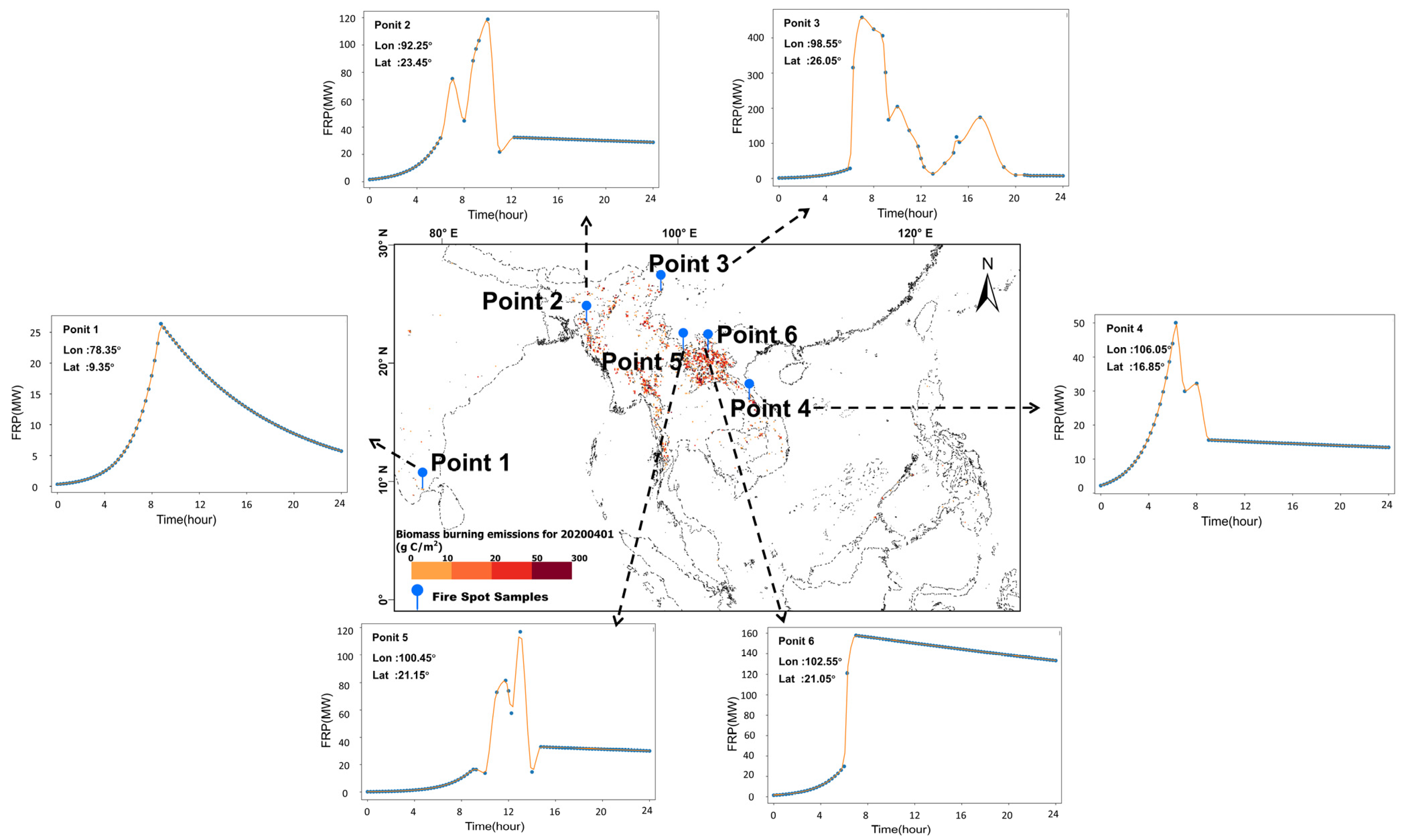
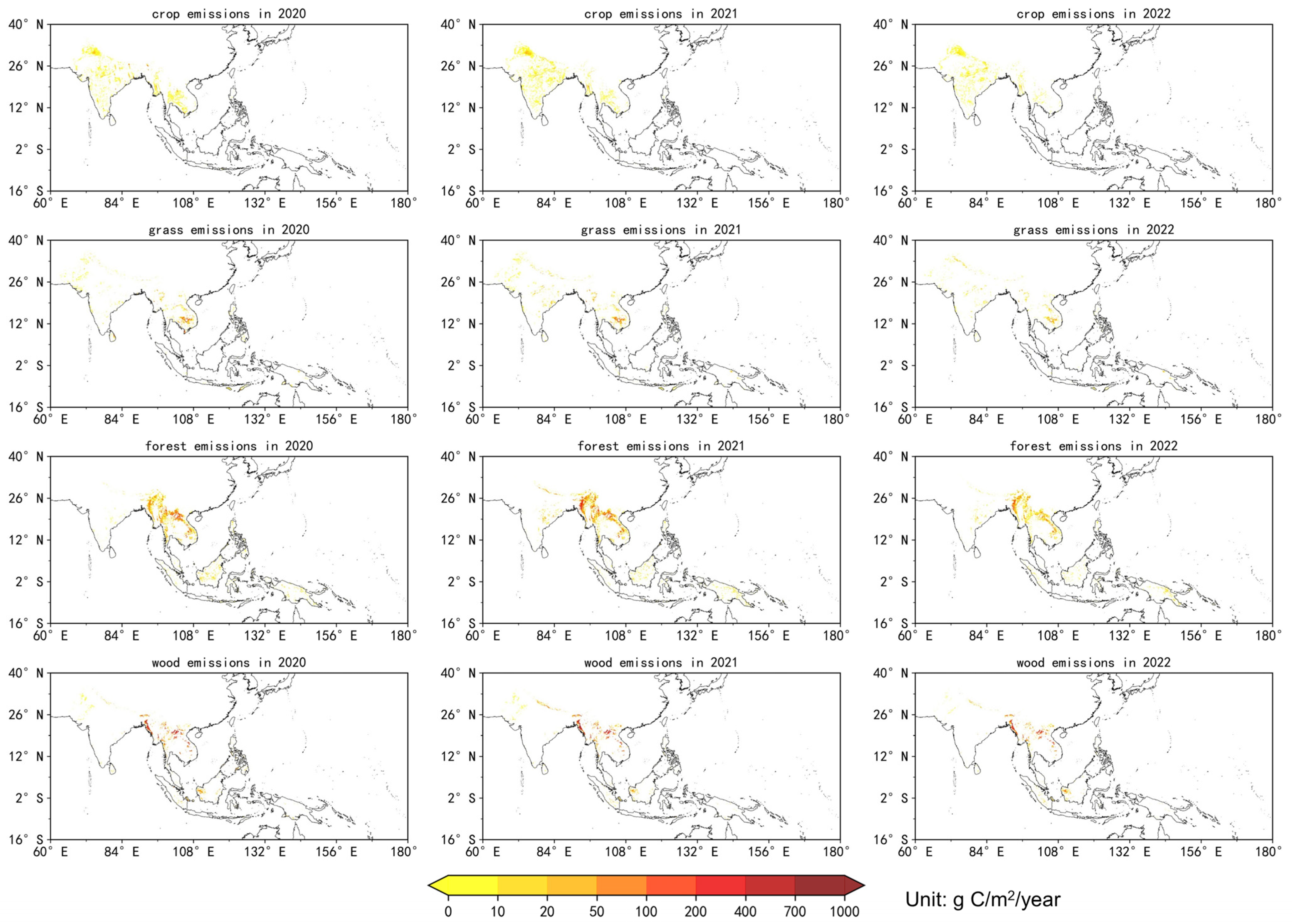
| IGBP Description | Value | Reclassification Results |
|---|---|---|
| Evergreen Needleleaf Forests | 1 | forest |
| Evergreen Broadleaf Forests | 2 | |
| Deciduous Needleleaf Forests | 3 | |
| Deciduous Broadleaf Forests | 4 | |
| Mixed Forests | 5 | |
| Closed Shrublands | 6 | woodland |
| Open Shrublands | 7 | |
| Woody Savannas | 8 | |
| Savannas | 9 | grassland |
| Grasslands | 10 | |
| Permanent Wetlands | 11 | |
| Croplands | 12 | cropland |
| Urban and Built–up Lands | 13 | forest |
| Cropland/Natural Vegetation Mosaics | 14 | cropland |
| Permanent Snow and Ice | 15 | - |
| Barren | 16 | cropland |
| Water Bodies | 0 | - |
| Cropland | Grassland | Forest | Woodland | |
|---|---|---|---|---|
| C | 449.00 | 494.60 | 480.00 | 489.42 |
| CO2 | 1353.50 a | 1686.00 b | 1643.00 b | 1681.00 b |
| CO | 76.10 a | 63.00 b | 93.00 b | 67.00 b |
| CH4 | 2.80 a | 2.00 b | 5.10 b | 3.00 b |
| NMOG | 9.80 a | 28.20 b | 51.90 b | 24.80 b |
| H2 | 2.59 b | 1.70 b | 3.40 b | 0.97 b |
| NOX | 2.90 a | 3.90 b | 2.60 b | 3.65 b |
| SO2 | 0.40 a | 0.90 b | 0.40 b | 0.68 b |
| PM2.5 | 5.00 a | 7.17 b | 9.90 b | 7.10 b |
| TPM | 13.00 b | 8.30 b | 18.50 b | 15.40 b |
| TPC | 4.00 b | 3.00 b | 5.20 b | 7.10 b |
| OC | 2.00 b | 2.60 b | 4.70 b | 3.70 b |
| BC | 0.60 b | 0.37 b | 0.52 b | 1.31 b |
| NH3 | 1.40 a | 0.56 b | 1.30 b | 1.20 b |
| NO | 1.18 b | 2.16 b | 0.90 b | 0.77 b |
| NO2 | 2.99 b | 3.22 b | 3.60 b | 2.58 b |
| NMHC | 7.00 b | 3.40 b | 1.70 b | 3.40 b |
| PM10 | 6.30 b | 7.20 b | 18.50 b | 11.40 b |
| SEAS | EQAS | |||||
|---|---|---|---|---|---|---|
| 2020 | 2021 | 2022 | 2020 | 2021 | 2022 | |
| C | 170.5822 | 183.0390 | 143.9476 | 10.3839 | 13.0756 | 14.1371 |
| CO2 | 572.4475 | 613.6722 | 482.5472 | 34.6968 | 43.6592 | 47.2636 |
| CO | 31.3695 | 33.9839 | 26.7615 | 1.9934 | 2.5279 | 2.6993 |
| CH4 | 1.3547 | 1.4791 | 1.1661 | 0.0890 | 0.1136 | 0.1202 |
| NMOG | 4.4528 | 4.8964 | 3.8646 | 0.3015 | 0.3865 | 0.4060 |
| H2 | 0.7713 | 0.8309 | 0.6536 | 0.0479 | 0.0603 | 0.0648 |
| NOX | 0.9838 | 1.0414 | 0.8173 | 0.0562 | 0.0700 | 0.0771 |
| SO2 | 0.2674 | 0.2909 | 0.2292 | 0.0173 | 0.0220 | 0.0234 |
| PM2.5 | 3.2697 | 3.5596 | 2.8055 | 0.2121 | 0.2702 | 0.2870 |
| TPM | 5.2908 | 5.7275 | 4.5100 | 0.3351 | 0.4248 | 0.4541 |
| TPC | 2.1548 | 2.3459 | 1.8490 | 0.1398 | 0.1781 | 0.1892 |
| OC | 2.2049 | 2.4016 | 1.8930 | 0.1433 | 0.1827 | 0.1940 |
| BC | 0.2235 | 0.2424 | 0.1909 | 0.0143 | 0.0181 | 0.0193 |
| NH3 | 0.5454 | 0.5962 | 0.4701 | 0.0360 | 0.0460 | 0.0486 |
| NO | 0.4155 | 0.4419 | 0.3471 | 0.0243 | 0.0303 | 0.0332 |
| NO2 | 0.9546 | 1.0170 | 0.7989 | 0.0563 | 0.0704 | 0.0768 |
| NMHC | 1.7937 | 1.9171 | 1.5062 | 0.1074 | 0.1345 | 0.1460 |
| PM10 | 3.6313 | 3.9392 | 3.1032 | 0.2320 | 0.2947 | 0.3144 |
| FY-4A | FY-3D | GFED | GFAS | FEER | ||||||
|---|---|---|---|---|---|---|---|---|---|---|
| SEAS | EQAS | SEAS | EQAS | SEAS | EQAS | SEAS | EQAS | SEAS | EQAS | |
| 2020 | 170.58 | 10.38 | 217.46 | 16.81 | 115.83 | 13.51 | 96.14 | 24.59 | 208.80 | 56.43 |
| 2021 | 183.04 | 13.08 | 255.15 | 12.39 | 107.98 | 11.86 | 99.98 | 28.53 | 233.73 | 53.21 |
| 2022 | 143.95 | 14.14 | 119.27 | 10.41 | 56.32 | 9.84 | 52.49 | 21.94 | 143.00 | 54.00 |
| Total | 497.57 | 37.60 | 591.88 | 39.61 | 280.14 | 35.22 | 248.61 | 75.06 | 585.53 | 163.54 |
Disclaimer/Publisher’s Note: The statements, opinions and data contained in all publications are solely those of the individual author(s) and contributor(s) and not of MDPI and/or the editor(s). MDPI and/or the editor(s) disclaim responsibility for any injury to people or property resulting from any ideas, methods, instructions or products referred to in the content. |
© 2025 by the authors. Licensee MDPI, Basel, Switzerland. This article is an open access article distributed under the terms and conditions of the Creative Commons Attribution (CC BY) license (https://creativecommons.org/licenses/by/4.0/).
Share and Cite
Wang, Y.; Tian, Y.; Shi, Y. Estimation of Biomass Burning Emissions in South and Southeast Asia Based on FY-4A Satellite Observations. Atmosphere 2025, 16, 582. https://doi.org/10.3390/atmos16050582
Wang Y, Tian Y, Shi Y. Estimation of Biomass Burning Emissions in South and Southeast Asia Based on FY-4A Satellite Observations. Atmosphere. 2025; 16(5):582. https://doi.org/10.3390/atmos16050582
Chicago/Turabian StyleWang, Yajun, Yu Tian, and Yusheng Shi. 2025. "Estimation of Biomass Burning Emissions in South and Southeast Asia Based on FY-4A Satellite Observations" Atmosphere 16, no. 5: 582. https://doi.org/10.3390/atmos16050582
APA StyleWang, Y., Tian, Y., & Shi, Y. (2025). Estimation of Biomass Burning Emissions in South and Southeast Asia Based on FY-4A Satellite Observations. Atmosphere, 16(5), 582. https://doi.org/10.3390/atmos16050582








